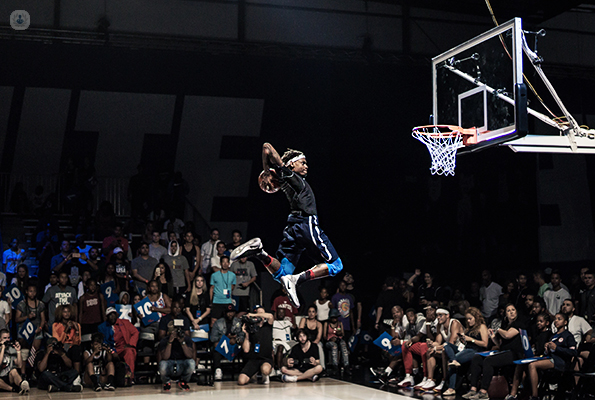What is jumper’s knee?
Autore:Jumper’s knee, also known as patellar tendonitis, is a type of knee injury that tends to develop over time. It gets progressively worse without treatment and could spell the end of an athlete’s professional career. What exactly is jumper’s knee and what can be done? Orthopaedic surgeon Mr Alex Chipperfield explains.

What is patellar tendonitis?
Patellar tendonitis is a condition when the patellar tendon (connection between the kneecap and shin bone) becomes inflamed and very painful. Generally, it will cause pain and tenderness around the front of the knee, particularly the lower part of the knee cap. The pain tends to be related to activity, with less pain at rest.
The term “jumper’s knee” came about because this condition is associated with athletes, especially those who participate in jumping sports such as basketball. Other athletes at risk are cyclists and runners. However, it is not exclusively a problem seen in athletes; being overweight is another risk factor for the condition.
Tightness or imbalance of other lower limb muscles such as hamstrings, gluteal muscles and quads can also be a contributing factor.
It is caused by tiny “micro-tears” in the substance of the tendon. These tears are slow to heal due to a poor blood supply to this area, and repeated trauma can lead to the tears persisting, causing chronic pain. Left untreated, jumper’s knee can lead to weakening and possible rupture of the patellar tendon.
Other conditions that can affect this area include infrapatellar bursitis, chondromalacia patella and Osgood-Schlatter disease.
What are the symptoms of patellar tendonitis?
Patellar tendonitis typically presents as an ache around the front of the knee. It is usually of insidious onset (not related to an injury).
The symptoms can be divided into four stages:
- Stage 1 – pain only after activity
- Stage 2 – pain during and after activity, but not enough to affect sporting performance
- Stage 3 – prolonged pain during and after activity, leading to poor sporting performance
- Stage 4 - complete tendon rupture (rare)
How long does it take jumper’s knee to heel?
Healing time for this condition depends on the stage of the injury.
Mild injuries (Stages 1 and 2) can recover within a month, given the right conditions.
More severe cases (Stage 3) may take up to nine months to recover.
Whatever the stage of the condition, the recovery time relies on adherence to the rehabilitation programme and a gradual return to sporting activities. Pushing too hard too soon can set the recovery back as a result of re-injury.
How can you injure the patellar tendon?
Patellar tendonitis is caused by repeated microscopic tears in the substance of the tendon as a result of overuse or overloading of the tendon.
As with most injuries, the natural response is for these tears to slowly heal with time.
The issue with patellar tendonitis is that the tears do not have enough time to heal between insults, leading to a chronic condition.

What exercises should you avoid if you have patellar tendonitis?
Simply put, listen to your body. You should avoid any exercises that aggravate your symptoms.
There are some movements and activities that are particularly provocative. These include:
- Deep squats
- Kneeling
- Breaststroke swimming
- Cycling with a low seat
Exercises that can HELP with patellar tendonitis include:
- Wall squats
- Step ups
- Freestyle swimming
How do you treat patellar tendonitis?
First and foremost, rest. Stop the activity that causes the pain and wait for it to recover fully before restarting in a controlled and gradual way.
Acute symptoms (pain and swelling) can also be relieved by ice packs, elevation and anti-inflammatory medicines (e.g. ibuprofen) taken as tablets or topical gels and creams.
Physiotherapy can be helpful in this condition. A prescribed course of eccentric quads exercises can be useful, as can strapping or taping the patella. Generalised strengthening exercises as described above can also help.
If rest, medication and rehabilitation is not enough, then a few more invasive treatments may be needed.
Injection therapy can help in some cases. The most common and successful injection is PRP (platelet-rich plasma). A sample of your blood is taken and processed to concentrate the natural healing proteins that are present. These are then injected into the tendon to help accelerate the healing process.
Steroid injections (cortisone) are to be AVOIDED in this condition as they can weaken the tendon.
In extremes cases, surgery can be used as a last resort. This consists of cutting away the chronically inflamed, non-healing areas in the tendon. The results of surgery are not predictable or reliable and it should not be considered as the first line of treatment.
If you are suffering from knee pain, visit Mr Chipperfield’s Top Doctors profile and book an appointment.



